“The discovery of a new dish does more for human happiness than the discovery of a new star.”
— Jean Anthelme Brillat-Savarin
That quote captures something deeply true — there’s a special kind of joy in discovering new flavors, especially when those flavors come wrapped in honey, almonds, and delicate spices. In Morocco, dessert isn’t just the end of a meal — it’s a cultural experience, a symbol of hospitality, and a celebration of centuries-old tradition.
Imagine walking through the bustling souks of Marrakech, the scent of freshly baked Moroccan sweets drifting through the warm air. Vendors offer delicate confections that are not only delicious but also visually stunning, each one a work of edible art. These are more than treats — they are the heart of Moroccan culture.
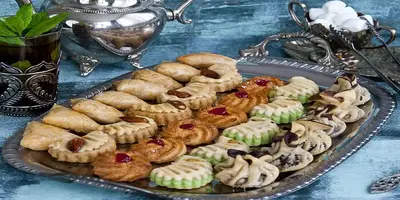
The Sweet Heritage of Morocco
Exploring traditional Moroccan desserts is like opening a window to the country’s soul. Rooted in centuries of history and enriched by cultural exchanges with Arab, Berber, and Mediterranean worlds, Moroccan pastries are a reflection of the land’s diverse heritage.
Every bite tells a story — of spice routes, royal kitchens, family secrets, and festive tables. These sweets are made not just to please the palate, but to honor guests and mark life’s most cherished moments.
Arab, Berber, and Mediterranean Influence
The vibrant fusion of influences is one of the reasons Moroccan pastries stand out. The aromatic floral waters (rose and orange blossom), ground nuts like almonds and pistachios, sweet dried fruits, and warm spices like cinnamon and anise all speak of a rich culinary tapestry.
Berber traditions bring local, wholesome ingredients such as honey and semolina. The Mediterranean connection shows up in the generous use of olive oil and citrus zest. The result? Unique desserts that are both rustic and refined
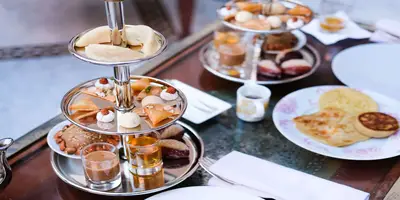
Moroccan Hospitality and the Role of Sweets
Hospitality is sacred in Moroccan culture — and desserts are its most delicious expression. Whether you’re visiting a friend’s home or attending a wedding, you’ll be greeted with trays overflowing with the best Moroccan desserts, artfully arranged to dazzle both the eye and the taste buds.
These desserts are never an afterthought. From intricately shaped chebakia Moroccan cookies to delicate layers of baklava Morocco-style, each treat is offered with pride and generosity.
Essential Ingredients in Moroccan Pastries
To recreate these delights at home, it's important to understand the ingredients that define them.
Nuts and Dried Fruits
Almonds are everywhere — whole, ground, toasted — and are often paired with walnuts, pistachios, or sesame seeds. Dried dates and apricots provide richness and natural sweetness, while raisins and figs occasionally make an appearance in regional specialties.
Sweeteners
Honey is the soul of many traditional Moroccan desserts. It’s used not just for sweetness, but for its deep flavor and glossy finish. Sugar and natural syrups may be used as well, depending on the region and occasion.
Spices and Aromatics
Cinnamon, anise, ginger, and cardamom give Moroccan pastries their signature warmth. Orange blossom and rose waters offer floral notes that elevate these treats into something poetic.
Specialty Flours
Semolina and almond flour are common bases. These flours give texture and density that define many Moroccan cookies and pastries, such as the ever-popular moroccan sellou — a flourless sweet made of roasted almonds, sesame, and honey, often served during Ramadan.
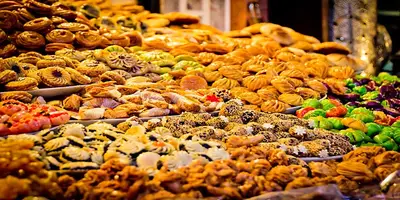
Traditional Tools and Modern Alternatives
Classic Moroccan baking often requires a few specific tools:
- Tadjine — Not just for savory stews, but also used for slow-cooked sweet dishes.
- Makroud mold — Used to shape diamond-shaped pastries filled with dates or nuts.
For the modern home baker, substitutes work just fine. A regular oven and a sharp cutter can help you replicate the intricate shapes and textures of these iconic desserts.
Learning the Basics of Moroccan Dessert Techniques
Mastering Moroccan sweets takes practice — but even a beginner can create magic with the right techniques.
Working with Phyllo and Warqa Dough
These ultra-thin pastry sheets are essential for layered desserts like baklava Morocco-style. Keep them moist, handle them gently, and always brush with melted butter or oil between layers.
Perfecting Syrups
Many Moroccan pastries are soaked in syrup after baking. Simmer your syrup with care — it should coat the pastry without making it soggy. Floral waters can be added for extra aroma.
Storing and Serving
Store pastries in airtight containers to maintain freshness. Present them on ornate trays or colorful Moroccan ceramics for an authentic feel — presentation is part of the experience.
 Halwa Chebakia: A Ramadan Classic
Halwa Chebakia: A Ramadan Classic
No list of popular Moroccan desserts would be complete without halwa chebakia. These sesame-studded, honey-drenched cookies are folded into floral shapes and deep-fried until golden.
Often made in huge batches during Ramadan, chebakia moroccan pastries are crunchy, sticky, and fragrant. They’re shaped with skill, fried in hot oil, and immediately soaked in warm honey infused with cinnamon and orange blossom water.
Their elaborate preparation makes them a true labor of love — and a celebration of Moroccan tradition.
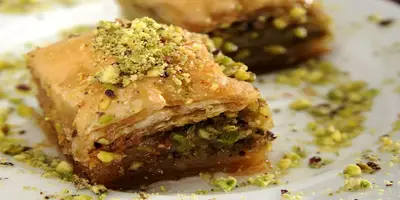
Baklava Morocco-Style: A Timeless Treat
While baklava is found across the Middle East, baklava Morocco has its own unique twist. Layered with nuts and phyllo, it’s sweetened with orange blossom honey and often garnished with ground pistachios or almonds.
You can try countless regional versions: some include raisins, others feature walnut-spice mixtures. However you make it, it remains one of the best Moroccan desserts to serve at weddings, feasts, or just with afternoon tea.
 Moroccan Cookies You Shouldn’t Miss
Moroccan Cookies You Shouldn’t Miss
Cookies, or moroccan cookies, are as central to Moroccan sweets as any pastry. They come in many forms — from the melt-in-your-mouth ghoriba to the crescent-shaped kaab el ghazal (gazelle horns).
Ghoriba: These shortbread cookies made with almonds, walnuts, or coconut are soft, crumbly, and lightly spiced.
Kaab el Ghazal: Filled with almond paste and shaped into elegant crescents, these are among the most traditional Moroccan desserts and a staple of celebrations.
Whether you’re enjoying one with tea or gifting them during Eid, Moroccan cookies always bring a taste of tradition.
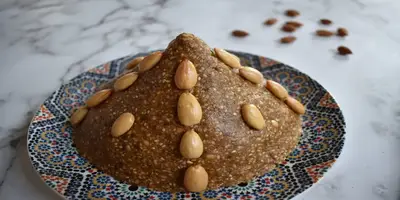
Moroccan Sellou: Nutrient-Rich and Flavor-Packed
Moroccan sellou, also known as sfouf, is a nourishing, energy-dense dessert often served during Ramadan or to new mothers. Made from roasted sesame seeds, ground almonds, and fried flour, it’s sweetened with honey and spiced with cinnamon.
Rich in protein and flavor, it’s a powdery, no-bake treat that’s often molded into pyramids or packed into jars. Unlike typical pastries, sellou is flourless and gluten-free, yet it remains one of the most beloved and traditional Moroccan desserts.
Festive and Seasonal Pastries
Many Moroccan desserts are linked to specific events or times of year. Their presence signals joy, gathering, and celebration.
Ramadan brings out trays of chebakia, sellou, and makroud (date-filled semolina pastries). Eid is a time for ghoriba and baklava. Weddings are incomplete without kaab el ghazal and other intricate pastries that represent blessing and prosperity.
These aren’t just desserts — they’re part of Morocco’s cultural rhythm.
Serving Moroccan Sweets Like a Local
Serving Moroccan pastries is an art. Always pair them with traditional Moroccan mint tea — the bitterness of the green tea balances the sweetness of the desserts beautifully.
For a modern twist, try:
- Chebakia with a dark espresso
- Baklava with vanilla ice cream
- Ghoriba with cinnamon latte
Present the desserts on colorful platters, scatter some crushed nuts around, or add edible flowers. In Moroccan culture, sweets are shared with love, pride, and an eye for beauty.
Final Thoughts: A Taste That Lasts
Exploring Moroccan desserts isn’t just a culinary adventure — it’s an invitation into a rich, warm culture. Whether you’re discovering traditional Moroccan desserts like kaab el ghazal, indulging in sticky halwa chebakia, or savoring modern takes on Moroccan pastries, you’re experiencing a tradition steeped in hospitality, memory, and joy.
No matter where you're from, there's something in Moroccan sweets that feels like home.
Morocco boasts a rich dessert tradition, where sweets are more than food — they’re part of cultural hospitality and celebration. Here are some of the most iconic Moroccan desserts:
- Halwa Chebakia
Deep-fried flower-shaped cookies made from sesame dough, soaked in honey, and sprinkled with sesame seeds. A must-have during Ramadan. - Kaab el Ghazal (Gazelle Horns)
Elegant crescent-shaped pastries filled with almond paste and delicately flavored with orange blossom water. Often served at weddings and special occasions. - Ghoriba
Crumbly shortbread cookies that come in many varieties: almond, walnut, coconut, or semolina. Perfect with mint tea. - Sellou (Sfouf)
A nutrient-rich, no-bake dessert made from roasted flour, almonds, sesame seeds, and honey. Common during Ramadan or after childbirth. - Baklava (Moroccan Style)
Layers of thin phyllo dough, nuts, and honey syrup, often flavored with orange blossom. Morocco adds its own twist with different nut blends and lighter spices. - Makroud
Date-filled semolina pastries, shaped into diamonds and either baked or fried. A traditional sweet found across North Africa, with Moroccan versions known for their rich texture.
These desserts are often served with Moroccan mint tea and beautifully arranged on colorful trays — an expression of Moroccan hospitality and artistry.
Chebakia is a Moroccan sesame cookie.
It’s made by folding strips of dough into a flower shape, frying them until golden, then coating them in honey and sprinkling with sesame seeds.
It’s sweet, sticky, and crunchy.
Moroccans traditionally serve Chebakia during Ramadan. It’s eaten at iftar, the meal that breaks the daily fast.
You’ll also find it during celebrations or special family gatherings, but Ramadan is when it’s most popular.
Moroccan baklava and Middle Eastern baklava share similar roots but differ in ingredients, flavor, and texture.
Here’s the difference:
- Dough and Texture
- Middle Eastern baklava uses paper-thin phyllo dough
- Moroccan baklava often uses warqa (a slightly thicker pastry) or homemade variations
- Moroccan version is usually denser and more compact
- Filling
- Middle Eastern baklava features chopped pistachios, walnuts, or cashews
- Moroccan baklava uses mostly almonds, sometimes mixed with cinnamon and orange blossom water
- Flavoring
- Middle Eastern baklava is flavored with rose water or orange blossom water
- Moroccan baklava leans more on cinnamon, anise, and sometimes gum arabic or mastic
- Syrup
- Middle Eastern versions use a simple syrup with lemon juice
- Moroccan syrup is richer, often with honey, and infused with orange blossom
- Shape
- Middle Eastern baklava is mostly cut into diamonds or squares
- Moroccan baklava may be rolled or layered differently, often cut in smaller shapes
Yes. Many Moroccan desserts can be made gluten-free.
Here’s how:
Naturally gluten-free desserts
- Sellou (Sfouf): made with roasted almonds, sesame, and flaxseed. Replace flour with almond flour or gluten-free oat flour
- Kaab el Ghazal (if using gluten-free dough)
- Almond Briwat: use rice paper or gluten-free pastry wrappers
- Coconut Ghriba: made with coconut, sugar, and eggs—no flour needed
- Zaalouk desserts (fruit-based): fresh fruit salads with orange blossom water or cinnamon
How to adapt other desserts
- Replace wheat flour with almond flour, chickpea flour, or a gluten-free blend
- Use gluten-free phyllo for baklava or warqa substitutes
- For cookies (ghriba, fekkas), test small batches with gluten-free flour to get the texture right
Sellou (also called Sfouf) is a traditional Moroccan dessert.
It’s rich, nutty, and high in energy.
When it’s served
- During Ramadan
- After childbirth
- At weddings
- As a nourishing snack
Main ingredients
- Toasted flour
- Almonds
- Sesame seeds
- Honey
- Butter
- Ground cinnamon
- Anise seeds
- Gum Arabic (optional)
How it’s made
- Toast flour in a pan until golden
- Toast sesame seeds separately
- Fry or toast almonds, then grind them
- Mix flour, sesame, almonds, cinnamon, anise, and gum Arabic
- Add melted butter and honey
- Mix until crumbly but cohesive
- Serve loose in bowls or press into molds
Some are, but not all.
Overly sweet desserts
- Chebakia: fried and soaked in honey
- Baklava: layers of pastry, nuts, and syrup
- Sellou: high in honey and almonds
- Briwat (sweet): filled with almond paste and dipped in syrup
Moderate to mild sweetness
- Coconut Ghriba: sweet, but light
- Fruit salads: flavored with cinnamon or orange blossom, no added sugar
- Dates stuffed with almonds: naturally sweet
- Milk pastilla: uses phyllo, milk custard, and cinnamon sugar—lightly sweet if you reduce the sugar
How to control sweetness
- Use less honey or sugar
- Skip syrup dips and drizzle lightly
- Add lemon juice to balance flavors
- Use unsweetened nuts
Moroccan sweets are usually served with mint tea.
That’s the standard pairing.
Occasions
- After meals
- At celebrations (weddings, Eid, births)
- During Ramadan (especially for iftar)
- When hosting guests
How they’re presented
- On large decorative trays
- In small paper cups or doilies
- Grouped by type or mixed
- With tea served in a silver pot and small glass cups
Style
- Often bite-sized
- Served at room temperature
- Usually offered in multiples—you take a few, not just one


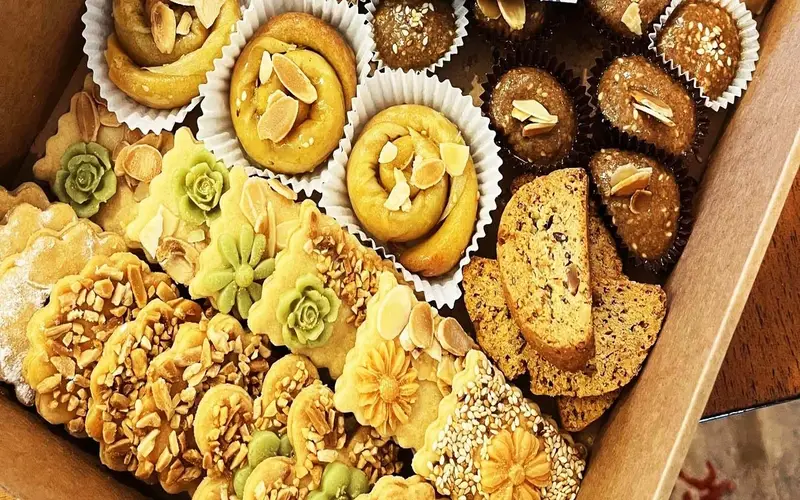
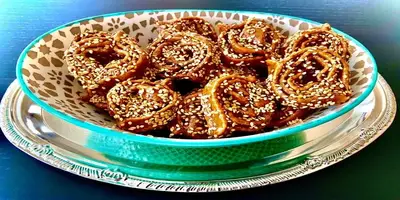 Halwa Chebakia: A Ramadan Classic
Halwa Chebakia: A Ramadan Classic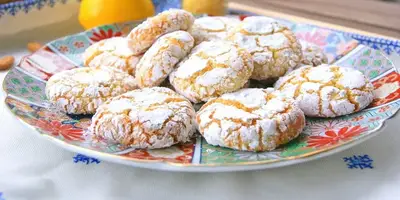 Moroccan Cookies You Shouldn’t Miss
Moroccan Cookies You Shouldn’t Miss